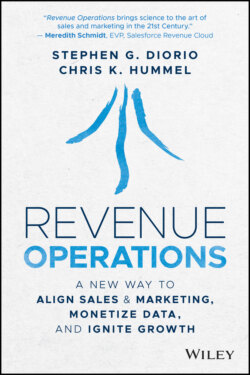Читать книгу Revenue Operations - Stephen Diorio, Chris K. Hummel - Страница 9
Introduction
ОглавлениеGrowth is good. Really good.
Growth elevates short-term performance. Growth has a disproportionate effect on valuation. Growth – especially organic growth – generates intangible goodwill and positive momentum among customers, influencers, analysts, and employees.
Here's the challenge: organizations too often treat growth like a disconnected, functionally driven art form rather than the interdisciplinary, data-driven science it should be.
The core revenue-facing functions – Marketing, Sales, and Service – all operate in silos. Each function is trying to do its individual job and maximize the impact of its activities on customers and revenue. Managers optimize the parts – brand, demand generation, pipeline conversion, retention rates, etc. – while coordination between the three is episodic, temporary, and heavily influenced by the personalities involved. They allocate resources as a cascade along organizational lines using historical precedents as the primary guide.
Even when this approach works, managers generally celebrate only the fact that growth happened, since they usually cannot explain why. Teams assume that someone else will take responsibility for the whole. When cross-functional collaboration happens, it requires Herculean efforts to marshal the collective troops and achieve one-time, almost artisanal objectives.
Who is ultimately responsible for coordination of key growth assets and initiatives in the business? That often falls on one person: the CEO. Because no other c-level officer typically controls more than 40% of the identified 18 levers of growth, CEOs get dragged into the nitty-gritty of optimizing all variables that cross organizational boundaries. There are a lot of these. Organizations may be built around functions, but real-world opportunities and challenges ignore those artificial boundaries.
So, we have functional experts trying to manage an interdisciplinary, multifaceted problem. This gap between the importance of growth to firm value and the limited understanding of how to achieve it creates heated discussions in boardrooms, management meetings, and planning sessions everywhere. What are we all missing?
Today we lack a system for growth.
Such systems for the back office and supply chain have already been developed over decades. It's time that we brought similar discipline, rigor, and methodology to the process of expanding our revenues. The three teams involved work hard and do their best, but somehow things just aren't clicking. The front office needs standardization and repeatability, too.
To understand how a systems-based approach to growth might work, let's look at what's happening inside each of the revenue-centric functions. To start, here are some common problems all functions are faced with:
The financial criteria for allocating growth resources, OPEX, and CapEx across these disparate functions differs wildly.
Change is everywhere. Not only does change scare people, but it raises questions about whether the benefits of transformation are worth the pain.
Real-world problems are interdependent and interdisciplinary. Regardless of what its org chart looks like, any business needs to manage the entire revenue cycle as an integrated whole before, during, and after the transaction.
The digital selling infrastructure, including the customer experience and data it generates, has become one of the biggest growth assets, even if ownership is unclear.
Investors, owners, and boards need more predictable and forward-looking forecasts.
Consistency, repeatability, and automation could help ensure that good performance is sustainable over time and scalable.
